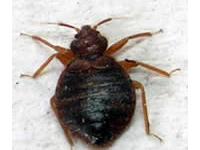Confused Flour Beetle (Also see Rust-Red Flour Beetle)
Granary Weevil (Also see Rice Weevil)
Mediterranean Flour Moth or Mill Moth
Red-legged Ham or Copra Beetle
Rice Weevil (Also see Granary Weevil)
Rust-Red Flour Beetle (Also see Confused Flour Beetle)
Tropical Warehouse or Almond Moth (Also see Warehouse, Tobacco or Cocoa Moth)
Warehouse, Tobacco or Cocoa Moth (Also see Tropical Warehouse or Almond Moth)

Appearance
Adults are 4-5 mm long, wingless, rounded, flat and reddish-brown. New hatched nymphs are translucent; nymphs resemble the adults and grow through 5 moults before reaching maturity.
Life Cycle
Eggs (up to 350), 0.8-1.3mm long, ink-bulb-shaped, laid in cracks and crevices near host and cemented in place by glue; 5 nymphal stages lasting up to 50 days; adults can live for more than 1 year without feeding.
Notes
The common Bedbug (Cimex lectularius), is found in temperate regions across the world while in India and other tropical regions, the Tropical Bedbug (Cimex hemipterus) is more common. Usually found in human habitation, hiding in cracks and crevices in beds and bedding in the daytime, emerging at night to feed on human blood. Their bites dont cause much irritation, but the bugs possess stink glands on their thorax that cause a disgusting odour when disturbed. Though they can harbor pathogens in their bodies, including plague and hepatitis B,they have not been linked to the transmission of any disease and therefore not considered a medical threat. However, humans can get skin infections and scars from scratching bites. For causing disgust and sheer nuisance value, Bedbugs are perhaps the No.1 pest!

